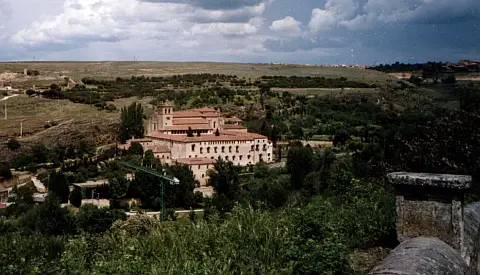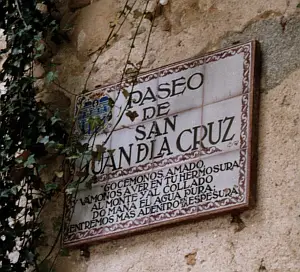Walking into the heart of Segovia
Story and photos by Beebe Bahrami
Looking past the surface of Segovia, Spain involves peeling back layers of religious history, seeing Christians, Pagans, Muslims, and Jews mixing in the stones and arches where the bloody Inquisition was also headquartered.

I climbed past the two–tiered, 118–arched Roman aqueduct, with its fantastical merry–go–round of DaVinci–like creatures at the base, and into the heart of medieval Segovia. Flanked by the rivers Clamores and Eresma, the first settlers who saw the beauty and strategy of this hilltop perch were Iron Age Celts and they called their settlement Segobriga, "briga" coming from the Celtic deity, Brigit.

I'd just come from the 12th century Romanesque church of San Millán. There ochre stones glowed with hidden suns embedded in its mineral walls, and carved capitals revealed haloed saints and half donkey humans, mixing grace and folly with ease from a time when people weren't in denial about such things.
Next, I followed the narrow passageways of the old Jewish neighborhood, once a thriving center that would fold in and diminish. I walked a stone's throw from there to the main square. The Plaza Mayor was in cheerful animation, sun–dappled with people gathered at café tables sipping local wine and eating from little plates filled with an array of local cheeses, olives, and sausages. It was filled with sun, but I looked up and shivered.
I was standing in front of the church of San Miguel, where in 1474 Isabel was crowned queen. Six years later she would rubber–stamp the Inquisition; this city would become its headquarters. A city whose core once held a vibrant community of Jews, Christians, and Muslims, shifted in a stone's throw from three–way passages into one–way roads.
Looking to distance myself, I moved through walled Segovia and toward the Alcazar castle, al–qasr in Arabic, the now Germanic–looking Hapsburg fantasy that was once an Islamic fortress. This castle and its crenellated tower inspired Walt Disney's design for his Sleeping Beauty. It felt like Disneyland too, with Disneyland admissions fees. Instead, I went to the northern wall for free and took in the magnificent river valley below, where I spied a more humble tower.
Following a path beneath the castle, past the great ramparts, I plunged down into a lush forest. The footpath passed through the tiny enclave of San Marcos, complete with bubbling stream, stone bridge, orchard, and grazing sheep on a hill. By the time I passed the sheep and arrived at the tower, my skin tingled with warmth. The tower belonged to a round, 12–sided church built by the Knights of Malta in the 13th century.

The Church of La Vera Cruz was perched amidst a spring green hill with swaying red poppies, and purple, orange, and yellow wild flowers. Four long–haired women in flowing skirts in a gentle wind were ahead of me on the path, picking herbs and flowers. When I got to the entrance, the women were already inside, hands joined in a circle, wreaths of flowers on their heads. They were within the first level of two in this round temple.
As they performed their incantations of gratitude to the spirits of the Earth, Air, Water, and Fire, I climbed the stairs to the second level of the round space. There an elderly man sat alone in a room lined with benches, each embossed with a Maltese cross, forming a rose red wreath around the man deep in prayer. He moved his mouth silently, giving thanks to the Spirit of the earth, air, water, and fire.

Back outside, I saw that the path continued down toward a valley, a thick stand of trees, and a heavy stone building. When I arrived at the 17th century convent, a cheery man at the entrance welcomed me to St. John of the Cross's church.
I hadn't a clue that St. John—in whose mystical wisdom many paths mingled, be they pagan, Jewish, Islamic or Christian—was buried here. His tomb stood beneath a ceiling of magnificent blue inlay against golden wood beams forming an Islamic eight–pointed star so commonly incorporated into Christian architecture by commissioned Muslim craftsmen in Spain. That starry dome mirrored St. John's dark night and promising dawn.
I retraced my steps back toward the ramparts. Sheep returning home crossed my path and forced me to halt. Looking up, the setting sun streaked blazes of rose and purple across the ship–like castle on the hill and the golden stone of the city sang a chorus of harmonizing colors. There, I felt the heart of the city. As if on cue, above me on the hill of La Vera Cruz, the four women came out from the chapel and ran into the elderly man. They warmly greeted each other; he threw in a gentlemanly bow. Then I watched their five figures, one with a handful of rosary beads and the other four with flowers, leisurely make their way up to the walls of Segovia.

If you go:
Segovia is a lovely day–trip from Madrid but one that ought to allow enough time to really soak up the beauty of Segovia's Romanesque churches and medieval streets, in addition to the Roman aqueduct and the famous castle. A morning train from Madrid's Chamartin station will deposit you at Segovia's train station around two hours later and will pass through a beautiful mountain–valley–plain landscape. From the station it is an easy walk into the walled city.
The northern wall has a gate and passageway that opens to the countryside and grazing sheep below. There you can find St. John and other sacred splendors, all unfolding at the pace of your own footstep.
Beebe Bahrami is a widely–published freelance writer and cultural anthropologist who is the author of two books: The Spiritual Traveler Spain and Historic Walking Guides: Madrid. Her writing has appeared in many publications, including Michelin Green Guides and National Geographic Books. Prior to becoming a fulltime professional writer, she was a university professor, Fulbright scholar, ethnographic consultant, and editor for Expedition magazine. She earned her PhD from the University of Pennsylvania in anthropology. She divides her year between Europe and the USA.
Related articles:
The Goddess Still Lives Here by Beebe Bahrami
Running with Faith by Eliot Stein
The Penitent Legionnaire by Robert Ward
Other Europe travel stories from the archives
Copyright (C) Perceptive Travel 2010. All rights reserved.
- The Burning of the Devil in Guatemala by Luke Maguire Armstrong
- Crowd–Surfing in Bangladesh by Michael Buckley
- Travel Book Reviews
Books from the Author:

Buy The Spiritual Traveler—Spain: A Guide to Sacred Sites and Pilgrim Routes at your local bookstore, or get it online here:
Amazon US
Amazon Canada
Amazon UK
Fishpond (Australia)

Buy Historic Walking Guides: Madrid at your local bookstore, or get it online here:
Amazon US
Amazon Canada
Amazon UK
Fishpond (Australia)

